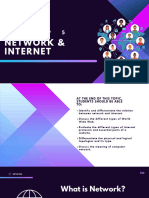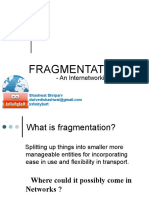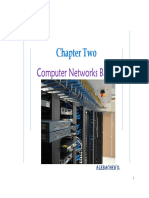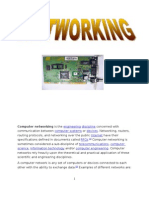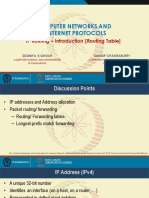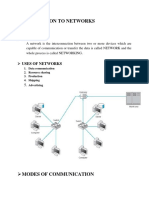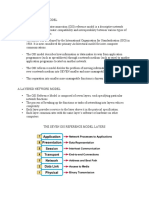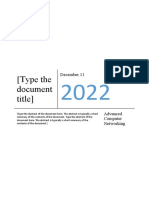0 ratings0% found this document useful (0 votes) 139 views23 pagesChapter 1 Introduction To Data Communication and Networks
Copyright
© © All Rights Reserved
We take content rights seriously. If you suspect this is your content,
claim it here.
Available Formats
Download as PDF or read online on Scribd
__y» Data Communications
and Networking Fourthtsition
Chapter 1
Introduction
Forouzan�The term telecommunication means communication at a
distance. The word data refers to information presented
in whatever form is agreed upon by the parties creating
and using the data. Data communications are the
exchange of data between two devices via some form of
transmission medium such as a wire cable.
Topics discussed in this section:
Components
Data Representation
Data Flow�Effective Characteristics of Data Communication
Delivery (intended Reciever )
Accuracy (unchanged data)
Timeliness
Jitter (uneven delay in audio/video streaming)�Figure 1.1 Five components of data communication
Protocol Protocol�Figure 1.2. Data flow (simplex, half-duplex, and full-duplex)
Direetion of data
© Full dupler
Mainframe ‘Monitor
SimpeR
Direction of dataat ime 1
El Direction ofdsts at umne2 Ee
1B Halfeduplex
Oecionofanalthe ue
(s2}- ——————_inJ�A network is a set of devices (often referred to as nodes)
connected by communication links. A node can be a
computer, printer, or any other device capable of sending
and/or receiving data generated by other nodes on the
network.
Topics discussed in this section:
Distributed Processing
Network Criteria
Physical Structures
Network Models
Categories of Networks
Interconnection of Networks: Internetwork�Network Criteria
Performance:
transit time (device to device)
response time (enquiry to response)
Throughput
delay
Reliability
Security�Figure 1.3 Types of connections: point-to-point and multipoint
{8 Point-to-point
Mainframe Station J
BOMURipeint
If several devices can use the link simultaneously, it is a spatially shared
connection. If users must take turns, it is a timeshared connection.
1.8�Figure 1.4 Categories of topology
Topology�1.10
Figure 1.5 A fully connected mesh topology (five devices)
* High speed, Little network
Sailure
seta
Suton Suton
* Privacy and Security
* Fault isolation
* Fault identification Genes sain]
* No. of links
* No. of I/O ports
* Costing�4.11
Figure 1.6 A star topology connecting four stations
Hub
Installation, reconfigure
Fault isolation and identification
Costing, I/O ports
Single point af dependency�Figure 1.7 bus topology comeeting three stations
= ay
Drop line Dropline Dropline
Cableend Cableend
Tap P Tap
Long distance issue
Installation
Number & length of cables
Reconnection, signal reflection
1.12�Figure 1.8 A ring topelogy connecting six stations
Unidirectional Dual ring
Instatlation
Repeaters
Fault isolation
1,13�Figure 1.9 A hybrid topology: a star backbone with three bus networks
Hub
1.14�1.15
Figure 1.10 Am isolated LA
connecting 12 computers to a hub in a closet�Categories of Networks
LAN
*Privately owned far office, home, buildings ete.
“limited to few kms.
sresource sharing.
“generally one type of transmission medium
sspeed
“WLAN
WAN
*Long distance transmission
“either complex (Switeled WAN) or simple (point to point W.
sesg, X25 >> Frame Relay >> ATM
“Wireloss WAN
MAN
+ High speed, DSL, Cable TV network
1.16�AAT
Figure 1.11 WANs: « switched WAN and a point-to-point WAN
ba Rolnt-toypolat WAN�1,18
ure 1.12 A heterogeneous network made of four WANs and pve LANS�1.19
The Internet has revolutionized many aspects of our daily
lives, It has affected the way we do business as well as the
way we spend our leisure time. The Internet is a
communication system that has brought a wealth of
information to our fingertips and organized it for our use.
Topics discussed in this section:
A Brief History
The Internet Today (ISPs)�1.20
Figure 1.13 Hierarchical organization of the Internet
Siena TT�1.21
In this section, we define two widely used terms: protocols
and standards. First, we define protocol, which is
synonymous with rule. Then we discuss standards, which
are agreed-upon rules.
Topics discussed in this section:
Protocols
Standards
Standards Organizations
Internet Standards�Protocols (rules)
what to communicate, how to communicate and when to
communicate
Key Elements of Protocols
L.Syntax
Structure of format of data
2.Semanties
Meaning of cach section bits
3.Timing
‘When to send and how fast...�1,23
Standards (agreed upon rules)
Categories of Standards
1.De facto.
By convention ar by fact
2.De jure.
By Law or by Government


